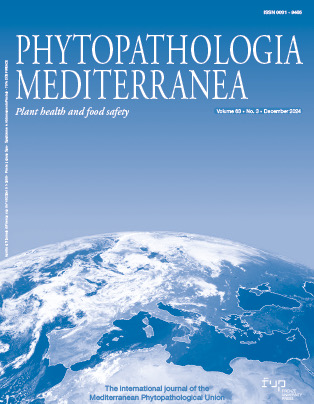Detection and characterization of Xylella fastidiosa in Iran: first report in alfalfa (Medicago sativa)
Published 2024-11-15
Keywords
- Detection,
- isolation,
- pathogenicity test,
- symptomatology
How to Cite
Copyright (c) 2024 Davood GHANBARI , Nader HASANZADEH, Mariam GHAYEB ZAMHARIR , Shaghayegh NASR, Kaoutar EL HANDI, Toufic ELBEAINO

This work is licensed under a Creative Commons Attribution 4.0 International License.
Funding data
-
H2020 Marie Skłodowska-Curie Actions
Grant numbers 734353
Abstract
Bacterial pathogens, especially Xylella fastidiosa (Xf), are significant threats to agricultural productivity, affecting economically important crops. The recent detection of Xf in Europe and the Middle East, including Iran, has emphasized the urgency for comprehensive surveillance to assess and understand the genetic diversity and distribution of this pathogen. A comprehensive survey from 2019 to 2022 was carried out in Iran to investigate Xf occurrence. A total of 403 samples were collected from alfalfa, almond, citrus, cherry, grapevine, olive, and pistachio plantations. Using serological (DAS-ELISA) and molecular (PCR) techniques, Xf was detected in nine samples from grapevine, five from almond, and 18 from alfalfa, and these include the first records Xf infections in alfalfa in Iran. Multiprimer-PCR assays carried out on Xf-infected plants, using ALM1/ALM2, XF2542-L/XF2542-R, and XF1968-L/XF1968-R primers for subspecies and strain differentiation, showed that the isolates from almond were Xf subsp. multiplex, and those from alfalfa were Xf subsp. fastidiosa. The Xf subsp. multiplex infecting almonds belonged to Xf genotype II. Pathogenicity tests carried out using Xf subsp. multiplex and fastidiosa isolates showed that the pathogen caused symptoms on Nicotiana benthamiana plants within 20 d post-inoculation. This study emphasizes the requirement for continuous monitoring, to mitigate the impacts of Xf on Iranian agriculture, and to prevent widespread outbreaks of this pathogen in multiple crop types.
Downloads
References
- Almeida R.P.P., Purcell, A.H., 2003. Biological traits of Xylella fastidiosa strains from grapes and almonds. Applied Environmental Microbiology 69: 7447–7452. DOI: https://doi.org/10.1128/AEM.69.12.7447-7452.2003
- Amanifar N., Babaei G., Mohammadi A.H., 2019. Xylella fastidiosa causes leaf scorch of pistachio (Pistacia vera) in Iran. Phytopathologia Mediterranea 58(2): 369–378.
- Amanifar N., Taghavi M., Salehi M., 2016. Xylella fastidiosa from almond in Iran: overwinter recovery and effects of antibiotics. Phytopathologia Mediterranea 55(3): 337-345.
- Amanifar N., Taghavi M., Izadpanah K., Babaei G., 2014. Isolation and pathogenicity of Xylella fastidiosa from grapevine and almond in Iran. Phytopathologia Mediterranea 53(2): 318–327.
- Avosani S., Nieri R., Mazzoni V., Anfora G., Hamouche Z., Zippari C., Cornara D., 2024. Intruding into a conversation: How behavioral manipulation could support management of Xylella fastidiosa and its insect vectors. Journal of Pest Science 97(1): 17–33. DOI: https://doi.org/10.1007/s10340-023-01631-7
- Castro C., Di Salvo B., Roper M.C., 2021. Xylella fastidiosa: A reemerging plant pathogen that threatens crops globally. PLoS Pathogens 17(9): e1009813. DOI: https://doi.org/10.1371/journal.ppat.1009813
- D’Attoma G., Morelli M., De La Fuente L., Cobine P.A., Saponari M., de Souza A.A., Saldarelli P., 2020. Phenotypic characterization and transformation attempts reveal peculiar traits of Xylella fastidiosa subspecies pauca strain De Donno. Microorganisms 8(11): 1832. DOI: https://doi.org/10.3390/microorganisms8111832
- El Handi K., Sabri M., Valentini F., De Stradis A., Achbani E.H., Hafidi M., El Moujabber M., Elbeaino T., 2022. Exploring active peptides with antimicrobial activity. In Planta against Xylella fastidiosa. Biology 11: 1685. https://doi.org/10.3390/biology11111685. DOI: https://doi.org/10.3390/biology11111685
- Hendson M., Purcell A.H., Chen D., Smart C., Guilhabert M., Kirkpatrick B., 2001. Genetic diversity of Pierce’s disease strain and other pathotypes of Xylella fastidiosa. Applied and Environmental Microbiology 67: 895–903. DOI: https://doi.org/10.1128/AEM.67.2.895-903.2001
- Hernandez-Martinez R., Costa H.S., Dumenyo C.K., Cooksey D.A., 2006. Differentiation of Strains of Xylella fastidiosa Infecting Grape, Almonds, and Oleander Using a Multiprimer PCR Assay. Plant Disease 90: 1382–1388. https://doi.org/10.1094/PD-90-1382. DOI: https://doi.org/10.1094/PD-90-1382
- Karimishahri M.R., Paltrinieri S., Sajadinejad M., Contaldo N., Bertaccini A. 2016. Molecular detection of prokaryotes in apricot showing decline and leaf scorch symptoms in Iran. Phytopathogenic Mollicutes 6(1): 33. https://doi.org/10.5958/2249-4677.2016.00006.2. DOI: https://doi.org/10.5958/2249-4677.2016.00006.2
- Lopes S.A., Ribeiro D.M., Roberto P.G., França S.C., Santos J.M., 2000. Nicotiana tabacum as an experimental host for the study of plant-Xylella fastidiosa interactions. Plant Disease 84: 827–830. https://doi.org/10.1094/PDIS.2000.84.8.827. DOI: https://doi.org/10.1094/PDIS.2000.84.8.827
- Loureiro T., Mesquita M.M., Dapkevicius M.D.L.E., Serra L., Martins Â., Cortez I., Poeta P., 2023. Xylella fastidiosa: A glimpse of the Portuguese situation. Microbiology Research 14(4): 1568–1588. DOI: https://doi.org/10.3390/microbiolres14040108
- Minsavage G.V., Thompson C.M., Hopkins D.L., Leite M.V.B.C., Stall R.E., 1994. Development of a polymerase chain reaction protocol for detection of Xylella fastidiosa in plant tissue. Phytopathology 84: 456–461. DOI: https://doi.org/10.1094/Phyto-84-456
- Nazarov P.A., Baleev D.N., Ivanova M.I., Sokolova L.M., Karakozova M.V., 2020. Infectious plant diseases: Aetiology, current status, problems and prospects in plant protection. Acta Naturae 12(3): 46. DOI: https://doi.org/10.32607/actanaturae.11026
- O’Leary M.L., Burbank L.P., 2023. Natural recombination among Type I restriction-modification systems creates diverse genomic methylation patterns among Xylella fastidiosa strains. Applied and Environmental Microbiology 89(1): e01873-22. DOI: https://doi.org/10.1128/aem.01873-22
- Picciotti U., Araujo Dalbon V., Ciancio A., Colagiero M., Cozzi G., De Bellis L., Porcelli F., 2023. “Ectomosphere”: Insects and microorganism interactions. Microorganisms 11(2): 440. DOI: https://doi.org/10.3390/microorganisms11020440
- Pierry P.M., Uceda-Campos G., Feitosa-Junior O.R., Martins-Junior J., de Santana W.O., Coletta-Filho H.D., da-Silva A.M., 2020. Genetic diversity of Xylella fastidiosa plasmids assessed by comparative genomics. Tropical Plant Pathology 45: 342-360. DOI: https://doi.org/10.1007/s40858-020-00359-4
- Wells J.M., Raju B.C., Nyland G., Lowe S.K., 1981. Medium for isolation and growth of bacteria associated with plum leaf scald and phony peach diseases. Applied and Environmental Microbiology 42: 357–363. DOI: https://doi.org/10.1128/aem.42.2.357-363.1981
- Woods L.C., Gorrell R.J., Taylor F., Connallon T., Kwok T., McDonald M.J., 2020. Horizontal gene transfer potentiates adaptation by reducing selective constraints on the spread of genetic variation. Proceedings of the National Academy of Sciences 117(43): 26868–26875. DOI: https://doi.org/10.1073/pnas.2005331117






